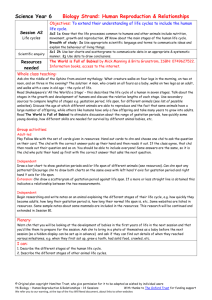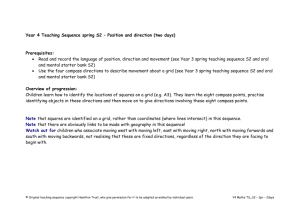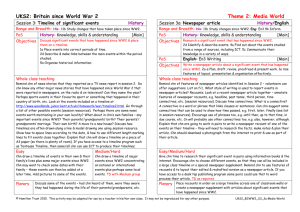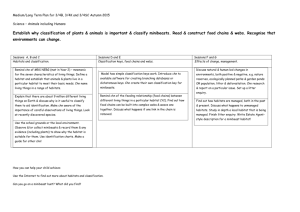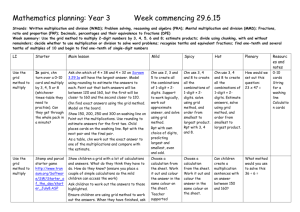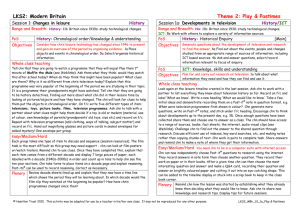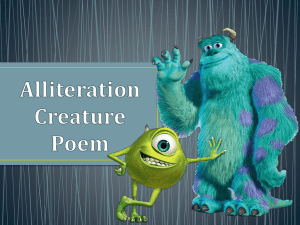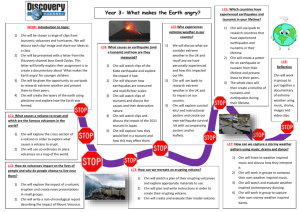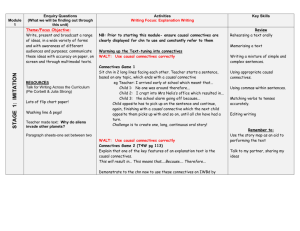Talk for Writing at SRS Based on the principles of Pie Corbett and
advertisement
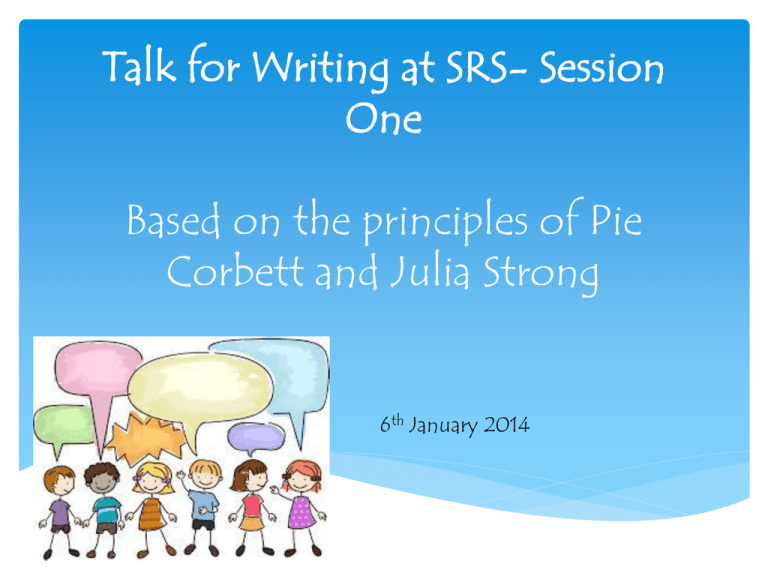
Talk for Writing at SRS- Session One Based on the principles of Pie Corbett and Julia Strong 6th January 2014 Aims of the session: • To introduce the key principles of Talk for Writing • To understand the importance of Shared Writing in the teaching of writing • To consider how these ideas might impact on the teaching and learning of writing in your class. Why do we need to look at the teaching of writing? Our data proves that children find writing significantly more challenging than reading… KS1 SATS Level 20072008 20082009 20092010 20102011 20112012 20122013 Reading L2+ 94% 95% 81% 88% 86% 82% L3 9% 10% 3% 15% 6% 7% L2+ 84% 79% 75% 61% 55% 57% L3 7% 6% 2% 17% 1% 1% L2+ 99% 98% 95% 91% 96% 90% L3 12% 12% 7% 22% 15% 18% Writing Maths What is Talk for Writing? “The externalisation of the internal dialogue that experienced writers hold when writing and consists of: * Book talk * Writer talk * Warming up to the text * Learning and remembering texts” In a nutshell, orally sharing the thinking involved in the writing process. What do good writers do? * Often read a lot and are good readers * Internalise language patterns and text structures * Read as writers (imitating their reading in their writing by appreciating and understanding the effect of literary techniques on the reader.) * Plan their text (in many different ways) * Draft and craft their writing What do the children in your class find most difficult when it comes to writing? How does this continue/change as we move through the school? The writing process can be broken down into three main steps: Step One- Imitation (familiarisation) Retelling a story/text until it can be retold fluently. Multi-sensory approach makes it memorable. Step Two- Innovation (adapting a known text/story) Substitution/addition/alteration/retelling from a different viewpoint but keeping basic story/text structure the same. Step Three- Invention (creating own new story/text) Building up own story/text ideas. The Three Part Approach to teaching writing Step One- Imitation (Familiarisation) • Reading a model text together and internalising the structure (fiction and non-fiction) by learning the text. Can you think of ways to help children to remember the structure and language features of a text? Ideas for Imitation Create a ‘story map’ of the text using pictures, symbols and words Retelling the story/text over and over in different ways (actions/phone calls etc) until it is embedded in long term memory. Drama Writing in role as a character from the text Comprehension Practise word and sentence level features using speaking frames etc. ‘Boxing up’ a text A Year One class telling The Little Red Hen story http://www.youtube.com/watch?v=JdvJZD-cplg The Three Part Approach to teaching writing Step Two- Innovation (developing from known stories/texts) • - Use the known text to create own similar version using: Substitutions (The Runaway Pancake/The Runaway Chapatti) Change of view point (The True Story of the …/retelling as a letter from characters) Reusing basic plot structure but changing the characters/setting The Three Part Approach to teaching writing Step Three- Invention (Independent application of the text type) • - Use what they know about the text type to write their own by: Writing about their own topics but all tackling the same text type Applying the text type across the curriculum. Whatever ideas you use for the Imitation, Innovation and Invention stages, children must be given opportunities to plan and talk through their ideas before writing. ALL writing should be preceded with Shared Writing, so that we are modelling the process of writing. What is Shared Writing and what might it look like in the classroom? http://www.youtube.com/watch?v=M8-aToC3brc Teaching Shared Writing Before doing any shared writing with your class, it’s crucial that YOU know what you want them to write and what specific features you want them to include. Writing your own text first helps you to do this. It also helps us to empathise with the children when we realise how long it takes us to write a decent piece of writing!! This can then be used as a prompt for you when you’re teaching it. TASK Using the current text type that you are doing, write your own piece of shared writing that you could use as a prompt, thinking about key features of the text type and key areas for development in your particular class. Plenary… Could you see some potential in using more shared writing across the curriculum in your classroom? Next session we will go into more depth about writer talk, book talk etc and more ideas for teaching the different genres. Please take a copy of each book and try to have a browse before next week then bring them to next week’s session. Talk for Writing at SRS- Session Two Based on the principles of Pie Corbett and Julia Strong 13th January 2014 The three stages of teaching writing- Imitation Innovation Invention How can Talk for Writing help our children? Writer Talk Role play and drama Word and Language Games During each stage of a unit of work, there are various ‘tuning in to the text’ activities that can help to promote understanding of the text and embed language structures- like the stocking fillers that Lesley has talked about before. Can you work out which activities could go with each genre? Tuning into the text- Recounts - Brain dump: Ask chn to think of a particular memory and write down all the words that they associate with that memory. Give time to rethink about the memory then add to the word list. - Spot the Truth- Use time connectives to tell 2 truths and one lie about themselves e.g. Last week, I shopped at Carrefour four times. When I was a toddler, my favourite food was marmalade. As a young child, I once ate a live baby frog. Partner has to suggest which was the untruth using given sentence starters e.g. It seems unlikely that… I’m not sure that you…’ etc. - Use engaging connectives- Ask chn to work in groups to find alternatives to the usual connectives- after a while; first; next etc using provided example texts or thesauruses etc. - Tenses- Today I…; Yesterday I… Show chn action cards. In pairs they have to say e.g. Today I run. Yesterday I ran. - Think about emotions of text e.g. brainstorm lists of synonyms for excited/happy/sad/angry etc. Tuning into the text- Explanations - Cause and Effect connectives- because and so. Show 2 sentences with no connective. E.g. The air cools. The water condenses. Chn to decide which connective would link. Then reorder and rehearse orally. Repeat with other sentences and chn invent their own. - Alternative connectives- Because of; As a result of; Due to; Because of the ship hitting an iceberg, it sank. Orally rehearse with different connectives. - Making up an explanation e.g. Why do dogs bark? Orally, chn have to work with a partner and explain for one minute why dogs bark. Swap partners and tasks. - Provide model text with missing connectives. Can chn work in pairs to oally decide on suitable connectives and justify. Tuning into the text- Persuasion - Chn work in pairs to persuade each other to: • Visit the Arctic • Visit the Moon - Practise 3 word rule of adjectives for exaggeration. Adrenaline-filled, actinpacked and breath-taking, spending your Winter break at …… will be a holiday to remember! - If….then… model sentences. If you enjoy…., then you’ll love…. - Post-it notes to identify key vocab/phrases for each feature to ‘magpie’ and use in own writing. E.g. Well chosen adjectives; alliteration; questions; specific verbs; imperatives etc - Model 3 questions e.g. Are you ever bored at the weekends? Are the kids driving you crazy? Why not head to Hawk Ridge Farm and experience a world of wonder. Chn to use model to create own 3 questions. - Cloze activities to practise using boastful language. Example Text- Information Text (non-chronological report) Don’t always stick to real life ‘things’- sometimes allowing children to use their imagination can allow them to focus on the language patterns. Stage One- Imitation Read a model text about a made-up animal e.g. a unicorn created by teacher. Act out text and story map it In pairs, say the text sentence by sentence using story map for support Pretend to be on the phone to a partner talking about unicorns. ‘Hot seating’ where one child/teacher is ‘expert’ on creature and others ask questions Film children talking about the model creature Model language structures e.g. - Did you know that unicorns live in…? - All unicorns have…. Pull out basic structure and language features. Example Text- Information Text (non-chronological report) Don’t always stick to real life ‘things’- sometimes allowing children to use their imagination can allow them to focus on the language patterns. Stage 2- Innovation Children could design and paint/collage their own type of lizard/dragon/unicornart cross-curricular link Lesson generating words/phrases to describe creature focusing on vocabulary development and labelling parts of their creature e.g. wings, tail, scales etc. Using original model text, Shared Writing of introduction then chn do own intro Day by day write next section of text E.g. Where does your creature live? Cross-curricular- Make diorama of habitat Describe where creature lives using language structures- All/Most/Some …….live in ….... Create similes to describe the creature- Its tail is as long as a …….. Add extra detail and reasons using connectives- also, and, because Example Text- Information Text (non-chronological report) Don’t always stick to real life ‘things’- sometimes allowing children to use their imagination can allow them to focus on the language patterns. Stage 3- Invention Using their knowledge of report writing in another area e.g. writing about a real animal or completely making up their own imaginary creature. Book Talk v Writer Talk On your tables, decide which statements you think are teaching ‘book talk’ and which are teaching ‘writer talk’. What are the differences between ‘Book Talk’ and ‘Writer Talk’? What is Book Talk? (When you are introducing children to the model text) • Talking about books with children and encouraging them to comment on and question ideas and themes within a text. • This includes, but is not solely, the teaching of comprehension which must be modelled and taught explicitly by teachers. What is Writer Talk? (When you are teaching children to write, encouraging them to think about the audience) • - Specifically reading a text in order to imitate it for use in own writing e.g. identifying how an author created suspense; ‘magpieing’ effective words and phrases that they could use in their own writing; collecting further examples teacher models through Shared Writing children apply in own writing so they are ‘writing as a reader’


